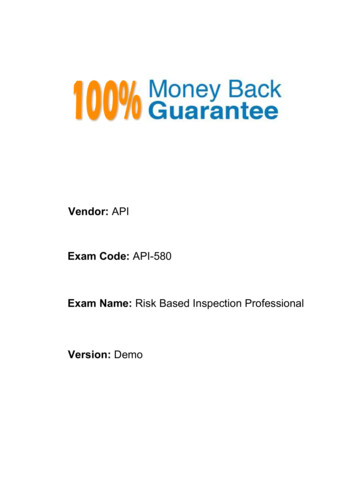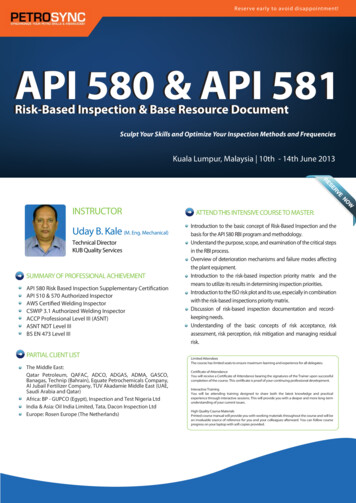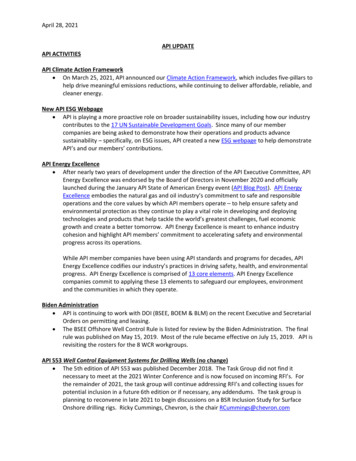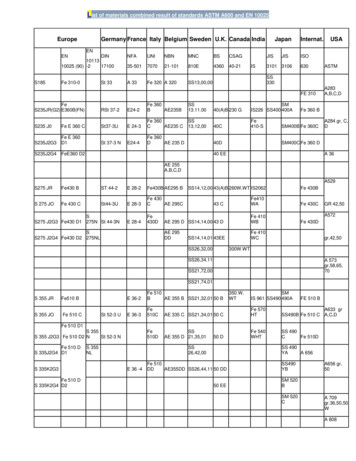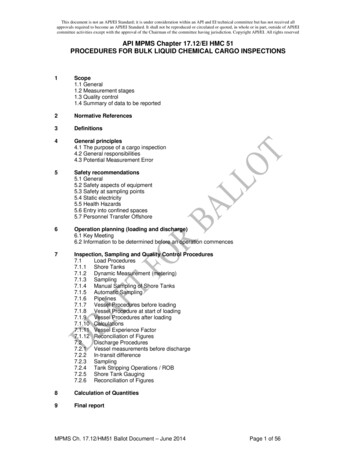
Transcription
This document is not an API/EI Standard; it is under consideration within an API and EI technical committee but has not received allapprovals required to become an API/EI Standard. It shall not be reproduced or circulated or quoted, in whole or in part, outside of API/EIcommittee activities except with the approval of the Chairman of the committee having jurisdiction. Copyright API/EI. All rights reservedAPI MPMS Chapter 17.12/EI HMC 51PROCEDURES FOR BULK LIQUID CHEMICAL CARGO INSPECTIONS1Scope1.1 General1.2 Measurement stages1.3 Quality control1.4 Summary of data to be reported2Normative References3Definitions4General principles4.1 The purpose of a cargo inspection4.2 General responsibilities4.3 Potential Measurement Error5Safety recommendations5.1 General5.2 Safety aspects of equipment5.3 Safety at sampling points5.4 Static electricity5.5 Health Hazards5.6 Entry into confined spaces5.7 Personnel Transfer Offshore6Operation planning (loading and discharge)6.1 Key Meeting6.2 Information to be determined before an operation commences7Inspection, Sampling and Quality Control Procedures7.1Load Procedures7.1.1 Shore Tanks7.1.2 Dynamic Measurement (metering)7.1.3 Sampling7.1.4 Manual Sampling of Shore Tanks7.1.5 Automatic Sampling7.1.6 Pipelines7.1.7 Vessel Procedures before loading7.1.8 Vessel Procedure at start of loading7.1.9 Vessel Procedures after loading7.1.10 Calculations7.1.11 Vessel Experience Factor7.1.12 Reconciliation of Figures7.2Discharge Procedures7.2.1 Vessel measurements before discharge7.2.2 In-transit difference7.2.3 Sampling7.2.4 Tank Stripping Operations / ROB7.2.5 Shore Tank Gauging7.2.6 Reconciliation of Figures8Calculation of Quantities9Final reportMPMS Ch. 17.12/HM51 Ballot Document – June 2014Page 1 of 56
This document is not an API/EI Standard; it is under consideration within an API and EI technical committee but has not received allapprovals required to become an API/EI Standard. It shall not be reproduced or circulated or quoted, in whole or in part, outside of API/EIcommittee activities except with the approval of the Chairman of the committee having jurisdiction. Copyright API/EI. All rights reservedAPI MPMS Chapter 17.12/EI HMC 51PROCEDURES FOR BULK LIQUID CHEMICAL CARGO INSPECTIONSAnnex AAnnex BAnnex CAnnex DAnnex E-Guidelines for verifying the accuracy of manual gauging apparatusMetering system performance at loadingWedge formula calculationOff shore operationsWall Wash OperationsMPMS Ch. 17.12/HM51 Ballot Document – June 2014Page 2 of 56
This document is not an API/EI Standard; it is under consideration within an API and EI technical committee but has not received allapprovals required to become an API/EI Standard. It shall not be reproduced or circulated or quoted, in whole or in part, outside of API/EIcommittee activities except with the approval of the Chairman of the committee having jurisdiction. Copyright API/EI. All rights reservedAPI MPMS Chapter 17.12/EI HMC 51PROCEDURES FOR BULK LIQUID CHEMICAL CARGO INSPECTIONS1SCOPE1.1GeneralThis document provides cargo measurement procedures for use primarily by inspectors specifiesprocedures directed at minimizing cargo contamination and losses. In the absence of, or inconjunction with, specific instructions from principal(s), this document should be considered asummary of good practice used within the industry.Where the term “measurement” is used in a general sense, it should be taken to include all aspects ofcargo inspection including (but not limited to) tank inspection, sampling, laboratory analysis andtesting and other superintending activities, as required by the inspector’s principals.The points at which inspectors are required to make their measurements are described anddefinitions of the terms used throughout this document are provided in Section 3. Whenever possibleterms approved by API, EI and ISO/TC28 have been adopted.The document also considers the purpose of a cargo survey and summarizes the generalresponsibilities. These procedures may become contractual if reference to them is made in either anomination or acknowledgement.Safety matters and related responsibilities are defined and emphasis is placed on the need forinspectors to be continually conscious that safety requirements take precedence over all otherconsiderations.The document describes the detailed procedures which inspectors should follow and providesreferences to analytical test methods and calculations. Reference is made to alternative methodssince it is recognized that opinions may vary regarding the use of test methods, and that differentmethods may be specified by the parties involved.1.2Measurement StagesWhen a cargo is transported by vessel from one shore terminal to another, measurements arenormally made at four locations, as shown in Figure 1 for the purpose of establishing:(a)(b)(c)(d)(e)the quantity of cargo delivered (i.e. to confirm the quantity of cargo shown on the Bill ofLading);the quantity of cargo loaded by the vessel;the quantity of cargo discharged by the vessel;the quantity of cargo received by the receiving terminal;the difference between the quantities established under (a) to (d) above.Note; for a particular voyage involving more than one loading port or discharge port, measurementsshould be made at all such additional ports in order that a reliable comparison can be made betweenthe quantities shown on the Bill of Lading, the cumulative outturn and ship’s figures.Note 2: For ship to ship transfer operations please refer to Annex DMPMS Ch. 17.12/HM51 Ballot Document – June 2014Page 3 of 56
This document is not an API/EI Standard; it is under consideration within an API and EI technical committee but has not received allapprovals required to become an API/EI Standard. It shall not be reproduced or circulated or quoted, in whole or in part, outside of API/EIcommittee activities except with the approval of the Chairman of the committee having jurisdiction. Copyright API/EI. All rights reservedAPI MPMS Chapter 17.12/EI HMC 51PROCEDURES FOR BULK LIQUID CHEMICAL CARGO INSPECTIONSShore to shore difference, (4-1) (2-1) (3-2) (4-3)Note: by convention, losses have a negative signFigure 1 Marine transfer measurement points1.3Quality ControlIt is recognized that contamination may occur during the various transfer and transportation stages ofcargo movement.Procedures and recommendations for a testing schedule are given which can help to minimize suchcontamination risk.1.4Summary of Data to be ReportedDue to the reporting requirements of each cargo inspection company and their clients(principals), specific reporting formats are not recommended in this document. However a listing ofthe typical information sufficient to define a cargo loading or discharge operation is provided inSection 4. This listing represents a consensus of a number of cargo inspection companies and theirprincipals. The detailed format of these forms should be agreed with principals when contracts arebeing arranged.MPMS Ch. 17.12/HM51 Ballot Document – June 2014Page 4 of 56
This document is not an API/EI Standard; it is under consideration within an API and EI technical committee but has not received allapprovals required to become an API/EI Standard. It shall not be reproduced or circulated or quoted, in whole or in part, outside of API/EIcommittee activities except with the approval of the Chairman of the committee having jurisdiction. Copyright API/EI. All rights reservedAPI MPMS Chapter 17.12/EI HMC 51PROCEDURES FOR BULK LIQUID CHEMICAL CARGO INSPECTIONS2 Normative References2.1 GeneralThe following referenced documents are indispensable for the application of this document. For datedreferences, only the edition cited applies. For undated references, the latest edition of the referenceddocument (including any amendments) applies2.2 API/EI DocumentsEI HM 49/API MPMS Chapter 17.9EI HM 54/API MPMS Chapter 17.5EI HM 52/API MPMS Chapter 17.11“Vessel Experience Factor”“Guidelines for Cargo Analysis and Reconciliation”“Measurement and Sampling of Cargoes on BoardVessels using Closed and Restricted Equipment”Tank2.3 EI DocumentsEI HM 4“Manual methods for the measurement of level in tanks - Non- electricalmethods”“Field guide to proving meters with a pipe prover”EI HM 102.3 API DocumentsAPI MPMS Chapter 3.1BAPI MPMS Chapter 4.5API MPMS Chapter 8.2API MPMS Chapter 11.1API MPMS Chapter 17.2API MPMS Chapter 17.6API MPMS Chapter 17.8“Standard Practice for Level Measurement of Liquid Hydrocarbons inStationary Tanks by Automatic Tank Gauging”“Master- Meter Provers”“Standard Practice for Automatic Sampling of liquid Petroleum andPetroleum Products”“Temperature and Pressure Volume Correction Factors forGeneralized Crude Oils, Refined Products, and Lubricating Oils”“Measurement of Cargoes on Board Tank Vessels”“Guidelines for Determining the Fullness of Pipelines betweenVessels and Shore Tanks”“Guidelines for Pre-Loading Inspection of Marine Vessel CargoTanks”2.4 API/ASTM DocumentsAPI MPMS Chapter 8.2/ASTM D 4177“Standard Practice for Automatic Sampling of liquidPetroleum and Petroleum Products”2.5 American Society for Testing and Materials (ASTM)ASTM E2664 – Method for methanol wall wash of marine vessels handling polyester grade MEG2.6 Other DocumentsISO 4268:ISO 4512:Petroleum and liquid petroleum products -Temperature measurement - ManualmethodsPetroleum and liquid petroleum products - Equipment for measurement of liquidlevels in storage tanksMPMS Ch. 17.12/HM51 Ballot Document – June 2014Page 5 of 56
This document is not an API/EI Standard; it is under consideration within an API and EI technical committee but has not received allapprovals required to become an API/EI Standard. It shall not be reproduced or circulated or quoted, in whole or in part, outside of API/EIcommittee activities except with the approval of the Chairman of the committee having jurisdiction. Copyright API/EI. All rights reservedAPI MPMS Chapter 17.12/EI HMC 51PROCEDURES FOR BULK LIQUID CHEMICAL CARGO INSPECTIONSIMO -International Maritime OrganizationIMO/IBC - “International Code for the Construction and Equipments of Ships carryingDangerous Chemicals in Bulk”ISGOTT - International Safety Guide for Oil Tankers and TerminalsMarpol Tanker Safety Guide (Chemicals)Annual book of ASTM Standards:Section 5 - Petroleum products, lubricants and fossil fuels - Volumes 5.01, 5.02, 5.03, 5.04Section 6 - Paints, solvents and aromatics - Volumes 6.04MPMS Ch. 17.12/HM51 Ballot Document – June 2014Page 6 of 56
This document is not an API/EI Standard; it is under consideration within an API and EI technical committee but has not received allapprovals required to become an API/EI Standard. It shall not be reproduced or circulated or quoted, in whole or in part, outside of API/EIcommittee activities except with the approval of the Chairman of the committee having jurisdiction. Copyright API/EI. All rights reservedAPI MPMS Chapter 17.12/EI HMC 51PROCEDURES FOR BULK LIQUID CHEMICAL CARGO INSPECTIONS3. Definitions3.1AccuracyCloseness of agreement between the result of a measurement and the (conventional) truevalue of a measurement.3.2BallastWater taken on board when a vessel is empty or partially loaded/discharged to increase draft toproperly submerge the propeller and maintain stability and trim.3.3Capacity tableTable showing the liquid or vapor space volume capacities, on an innage or outage basis, in a tank ortank car, at various liquid levels, measured at the reference gauge point: from thereference gauge point to the liquid level for liquid outage capacity.3.4Critical zoneThe distance between the point where a floating roof is resting on its normal supportsand the point where the roof is floating freely is referred to on a tank capacity table as the"Critical Zone"3.5DensityThe density of a quantity of a homogeneous substance is the ratio of its mass toits volume. The density varies as the temperature changes and is thereforegenerally expressed as the mass per unit of volume at a specified temperature.3.6Density (Relative)The ratio of the mass of given volume of liquid at 15 degrees C (or other standard temperature, suchas 60 degrees F) to the mass of an equal volume of pure water at the same temperature. Whenreporting results, explicitly state the standard reference temperature (for example, relative density15/15 degrees C).3.7Dipthe depth of liquid in a storage tank.3.8Displacer (tank gauging)Surface-detecting element which is suspended from a level gauge and moves in a verticaldirection to follow the change in liquid level.3.9Floating coverA lightweight covering of either metal or plastic material designed to float on thesurface of the liquid in a tank. Alternatively, a floating cover may be supported by a float system sothat it is just above the free-liquid surface. The device is usedMPMS Ch. 17.12/HM51 Ballot Document – June 2014Page 7 of 56
This document is not an API/EI Standard; it is under consideration within an API and EI technical committee but has not received allapprovals required to become an API/EI Standard. It shall not be reproduced or circulated or quoted, in whole or in part, outside of API/EIcommittee activities except with the approval of the Chairman of the committee having jurisdiction. Copyright API/EI. All rights reservedAPI MPMS Chapter 17.12/EI HMC 51PROCEDURES FOR BULK LIQUID CHEMICAL CARGO INSPECTIONS3.10Floating roof tankA tank in which either an external or an internal roof floats freely on the surface of the liquid contentsexcept at low levels when the weight of the roof is transmitted by its supporting legs to the tankbottom.3.11GaugingA process to determine the depth of liquid in a tank, which is measured from the upper referencegauging point to the liquid surface, or to the tank bottom or to a fixeddatum plate.3.12Inert GasA gas that does not react with the surroundings.3.13InhibitorsCompound (usually organic) that retards, controls, or stops an undesired chemical reaction, suc
EI HM 54/API MPMS Chapter 17.5 “Guidelines for Cargo Analysis and Reconciliation” EI HM 52/API MPMS Chapter 17.11 “Measurement and Sampling of Cargoes on Board Tank Vessels using Closed and Restricted Equipment” 2.3 EI Documents EI HM 4 “Manual methods for the measurement of level in tanks - Non- electrical methods” EI HM 10 “Field guide to proving meters with a pipe prover” 2 .

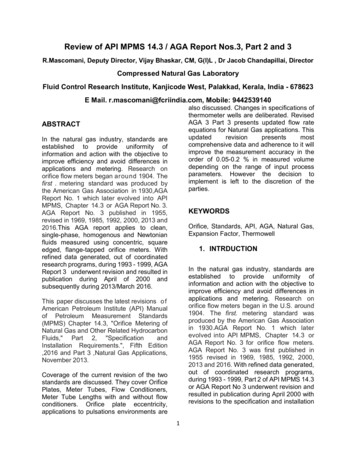
![API Ballot: [Ballot ID] – API 510 & API 570, Deferrals, Rev05](/img/5/api510andapi570deferralsrev5.jpg)

